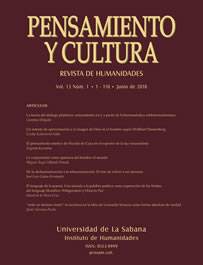El pensamiento estético de Nicolás de Cusa en el espectro de la luz renacentista
Keywords:
Mimesis, creation, image, mirror, art.Abstract
Nicholas de Cusa is a key figure in Renaissance aesthetic and philosophic thinking, and unveiled its fundamental tendencies in his metaphysics. He anticipates some of the characteristics of the modern era, but without completely rejecting medieval intellectualism and universalism. The philosophical conception of Nicholas de Cusa intrinsically includes profound aesthetic reflection. The German cardinal demonstrates great interest in the problems of mimesis, creation, visual perception and variety. A fundamental characteristic of his approach is the use of metaphors related to the plastic arts, the optical sciences and mathematics. The aesthetics of Nicholas de Cusa and the artistic practice and theory of the Renaissance are two components of a common paradigm, and while the objectives of mystic theology and art are different, the means to reach their ends can be similar and mutually enlightening.
Downloads
Issue
Section
License
1. Proposed Policy for Journals That Offer Open Access
Authors who publish with this journal agree to the following terms:
This journal and its papers are published with the Creative Commons License Attribution-NonCommercial-NoDerivatives 4.0 International (CC BY-NC-ND 4.0). You are free to share copy and redistribute the material in any medium or format if you: give appropriate credit, provide a link to the license, and indicate if changes were made; don’t use our material for commercial purposes; don’t remix, transform, or build upon the material.


